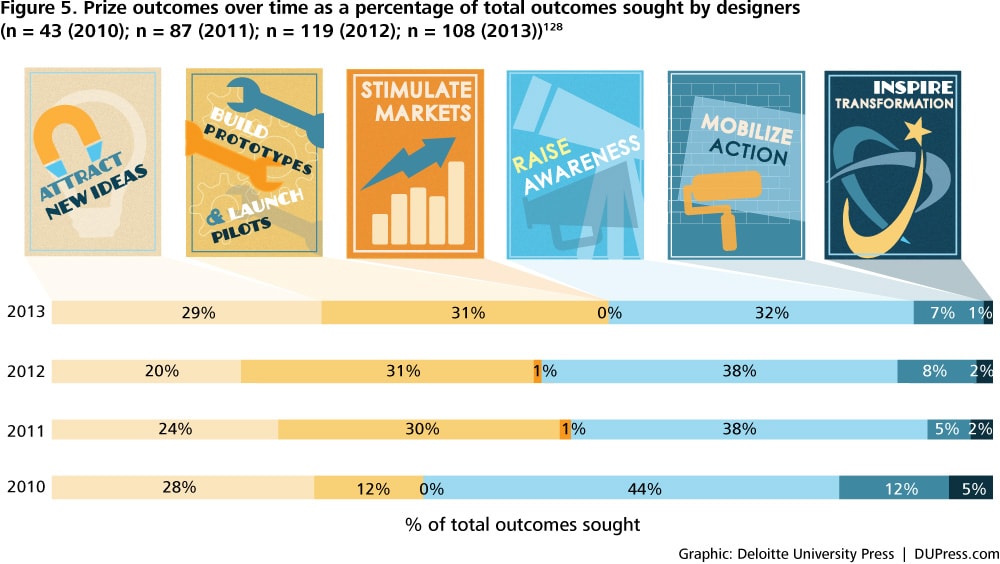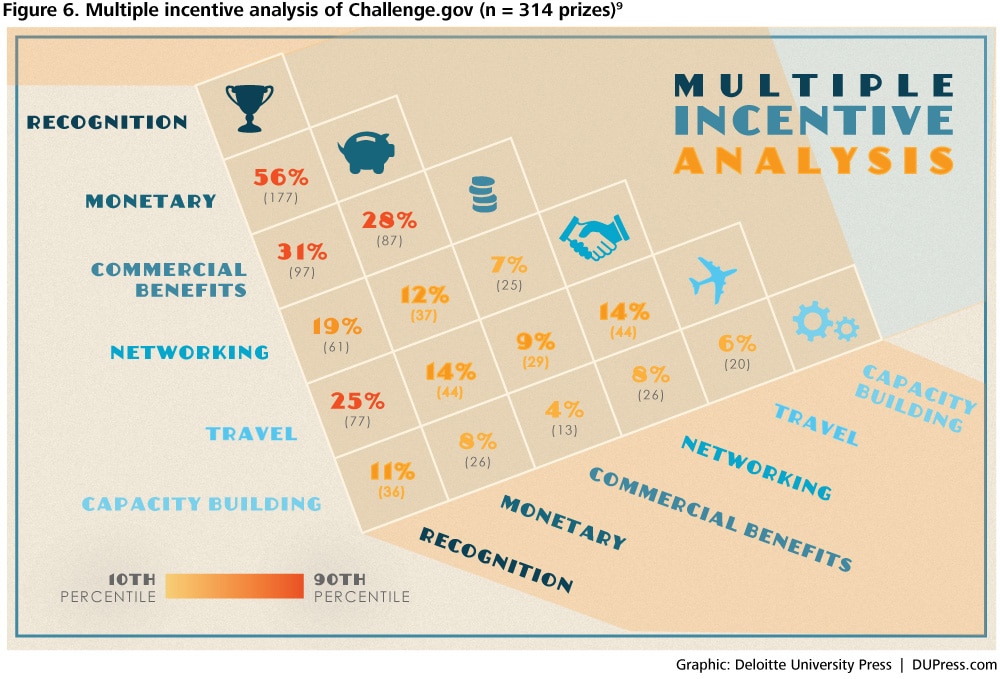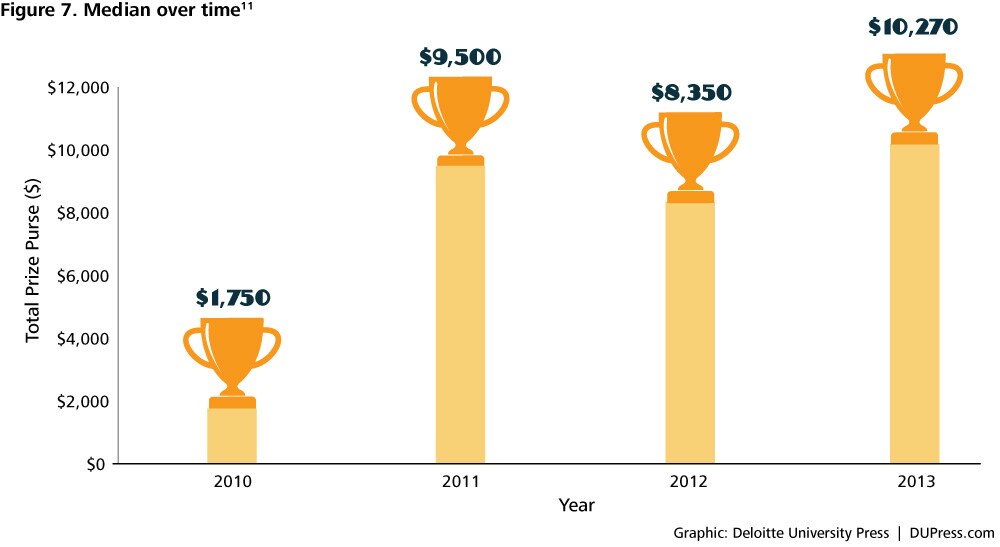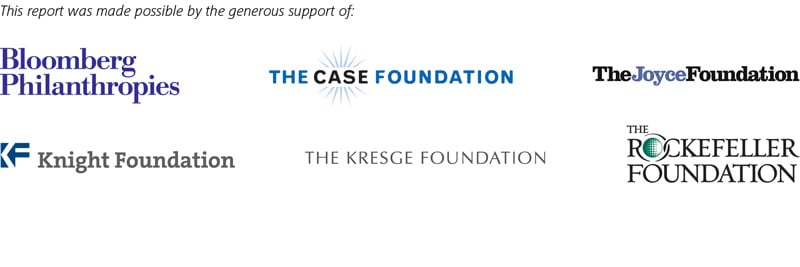The craft of incentive prize design has been saved

The craft of incentive prize design Trends and insights
18 June 2014
 Kwasi Mitchell, Ph.D. United States
Kwasi Mitchell, Ph.D. United States Nes Parker United States
Nes Parker United States Sahil Joshi United States
Sahil Joshi United States- Jesse Goldhammer, Brad Anderson
Several trends in incentive prize design have emerged that provide insight into how designers are building effective challenges to get the greatest return from their investments.
Trends and insights
Based on the analysis conducted for this report, three trends have emerged over the past five years that provide insight into how designers are building effective challenges and focusing their time, energy, and creativity to get the greatest return from their investments. All of this activity is helping prizes become a standard part of the challenge landscape and an important innovation tool that public sector leaders can use to pursue their missions. In the future, prizes will likely become commonplace and will be integrated even more tightly with challenges and other complementary problem solving strategies that public sector leaders use to drive change.
Challenges are becoming bolder and more sophisticated
Within the US government in particular, designers are increasingly expanding the scope, scale, and complexity of challenges and dedicating additional resources to fuel their ambitions.1 These designers are using challenges to achieve multiple outcomes, experimenting with customized designs, and seeking to engage ever-larger audiences in public sector-focused innovation. The growing popularity of complex challenges can be seen in the shifting mix of desired outcomes over time. While designers have never sought outcomes in equal proportion, there has clearly been growth in the pursuit of bolder outcomes that require more complex design. After America COMPETES Reauthorization Act passed in 2010, public sector challenges focused on raising awareness and attracting new ideas as outcomes dominated the landscape. More recently, designers have been increasingly trying their hand at producing models, such as prototypes and pilots.
While challenges are becoming more complex on the whole, the most ambitious outcomes on both spectra—market stimulation and inspire transformation—continue to make up a very small percentage of challenges on Challenge.gov, comprising less than 2 percent of outcomes sought in the last three years. Nonetheless, certain designers, including philanthropic, international, state, and local organizations, have been pursuing challenges that are larger in scope, targeting the more ambitious ends of the outcomes dimensions in greater percentages. As designers continue to experiment with increasing levels of complexity, there is an opportunity to capitalize on these more ambitious outcomes.
Challenge designers are partnering in new ways
Designers have focused on achieving these more complex outcomes by maturing their interactions with external organizations. In part, these collaborations help to reduce the risk of taking on challenges alone, because designers often need to supplement their own capabilities with outside partnerships. To obtain this kind of support, novice designers are moving beyond their organization’s traditional partnerships and looking to experienced designers for support and guidance. Such experienced designers frequently come from organizations that have developed extensive design expertise though execution over the years and are willing to share both guidance and resources. NASA, HHS, and USAID provide examples of how agencies are partnering in new ways to improve challenge design and administration.3US government agencies are collaborating with each other to share insights and best practices as well as increase the impact of their challenges.4 For example, NASA has consistently brought its deep design expertise to its partners, such as in the LAUNCH challenge with USAID, Department of State, and NIKE Inc. Additionally, the My Air, My Health challenge, which is jointly administered by the HHS and the EPA, relies on each organization’s particular expertise to incent solvers to develop sensors that track pollutant effects on individual health.5 These agencies also worked with non-profits and private enterprises to capture key information critical to certain elements of the challenge. USAID’s Technology Challenge for Atrocity Prevention included Humanity United in the task of problem definition and then worked with InnoCentive to translate their technical requirements into something a broader external audience could understand.6All of these efforts illustrate how cross-government and cross-industry collaboration can yield stronger challenge design and broader reach than challenges pursued by organizations alone. As major advocates for the use of challenges in driving innovation and improved outcomes for social policy issues, philanthropic organizations will continue to play a major role in the public sector challenge design space. Because they are dedicating significant resources to challenges and are achieving successful outcomes, philanthropies have become one of the most important repositories of design knowledge. This expertise, coupled with philanthropies’ politically unconstrained focus on the public good, puts them in a unique position to serve as engines of challenge design innovation in the future.7New designers will continue to rely on these leading organizations for partnerships, guidance, and advice as they embark on building their first prizes and challenges.
Challenge designers are expanding their view of incentives and challenge structures that can attract participants
In recent years, there has been significant experimentation with incentive structures to attract participants. While discussions with successful designers reveal that monetary and recognition incentives remain important, there is a movement to expand the universe of what organizations can offer to participants. Incentives such as an advanced market commitment, travel, commercial benefits, and capacity building are less frequently used, but can be just as powerful for attracting participants as monetary rewards. Designers use multiple incentives to motivate participants. The Federal Virtual Challenge run by the US Army, which is focused on producing functioning prototypes of virtual environments while also mobilizing and supporting participant communities, provides a strong example of this trend. While the challenge includes a significant monetary purse (over $50,000), it also features other rewards, such as public recognition, travel to a demonstration conference, and networking and business opportunities among the virtual software community.8 These non-traditional incentives illustrate how prize designers can creatively mix different types of motivations to attract the right participants. While our Challenge.gov and supplemental data analysis shows that recognition and monetary incentives were used in the majority of challenges, there were also many challenges that featured alternative motivations and combined multiple incentives to create a more effective draw (see figure 6).
While the use of monetary awards may not be the only incentive that designers use, there are some trends specifically related to this incentive that illuminate how designers approach their purse decisions. Over the past few years, there has been a jump in large purses. In 2010, there were only two federal challenges with a total purse over $100,000. In 2012 and 2013, this number increased to 13 and 9 challenges, respectively. This sustained growth, however, has not been as consistent for the median purse size. There was a large median total prize purse increase from 2010 to 2011 (with a 543 percent increase from $1,750 to $9,500), but since then, the amount has hovered between $8,000 and $10,000. Our secondary dataset also suggests a similar plateauing effect (increasing from around $30,000 in 2010 and plateauing around $100,000 between 2011 and 2013). The disparity in purse size between the two datasets is likely due to the types of organizations (for example, philanthropies) in the second dataset (see appendix B for further details). Over the coming years, this focus on blending incentives to achieve outcomes will likely continue. Many expert designers believe that the incentives focused on bringing together and building communities will provide strong draws for participants.10 The convening of participants through the phases of a challenge can be transformative for both the participants and the designers themselves, as both groups ultimately learn a great deal about the ability of a challenge to effect change.
State- and locally focused challenges
Public sector leaders at the state and local levels are increasingly finding opportunities to compete in challenges as participants.12These challenges hold the promise of helping public sector leaders to advance their innovation agendas. Notable examples include the US Department of Education’s Race to the Top Fund and Bloomberg Philanthropies’ Mayors Challenge, which feature state and city government participants, respectively.
Challenges that engage government participants seek outcomes that range from hyper-local to broadly national:
Using challenges to create local solutions. The CoolCalifornia City Challenge,13 a partnership among the California Air Resources board, the University of California’s Renewable and Appropriate Energy Laboratory, and the Energy Upgrade California™ Initiative, is a competition between cities to reduce their carbon footprint. California cities win sustainability funding if they successfully lower household energy use and transportation emissions through personal and team-focused initiatives and solutions.
Launching challenges to garner national attention. The Talent Dividend Prize, sponsored by CEOs for Cities and the Kresge Foundation, will be awarded to the metropolitan area that exhibits the greatest increase in the number of post-secondary degrees granted per one thousand people over a four-year period. As part of the award, there will be a national promotional campaign featuring the winner to showcase the value of local talent development for other metropolitan areas. Currently, the prize has drawn participation from over 50 local governments.
As more governments participate in challenges, public sector leaders will need sound advice to determine when and how engage in these efforts. We offer below some general guidance based upon several high-profile examples, professional expertise, and inferences from our broader public sector challenge research.
1. Find a senior leader to sponsor challenge participation.
While several challenges, such as Bloomberg Philanthropies’ Mayors Challenge, target public sector leaders as their principal participants, most are not so specific. In these cases, government employees who wish to participate in a challenge will find that securing a senior government sponsor brings many advantages. From committing resources to managing stakeholders to communicating with the public, senior sponsors can help to create the conditions in which a state or local government can compete effectively. Through leadership and the power of convening, sponsors can also foster innovation and drive change. In fact, winning the challenge may not be the most urgent priority for sponsors who are willing to play this role. Challenge participation can focus government and citizens on innovative solutions that can still be pursued no matter who wins. Without the right sponsor, state and local challenge participants can have great difficulty translating their effort to compete into meaningful outcomes for their citizens.
2. Engage constituents in solution development.
There are several reasons why government participants should seek opportunities to engage their constituents. Engagement drives citizens’ awareness and buy-in that their tax dollars are being spent wisely to compete in a challenge that will bring tangible benefits. It helps to improve solution quality, as citizens can offer their governments ideas, expertise, and feedback about how best to develop the most powerful submissions. Finally, for some challenges, engagement is a formally evaluated requirement. Many challenge designers are now including community engagement and ease of implementation as part of their evaluation process. For example, the Georgetown University Energy Prize evaluates how participants demonstrate success in engaging their communities.14 What better way to address such criteria than with a solution co-designed and/or approved by the very constituents who will be impacted?
3. Plan for the work required to compete.
Because challenges designed for state and local government participants often seek bold outcomes, it can be difficult for participants to simply bootstrap their submissions with just a few resources. Rather, submission development can involve full-time staffs that will need to develop and launch new programs through intra-governmental collaboration and public-private partnerships. To understand what it will take to compete, participants should engage challenge designers to understand how the incentives and scoring are tied to desired outcomes. These conversations can lead to practical insights about how much time and effort will be required and how best to commit scarce resources. For recurring challenges, participants should also consider networking with winners from prior years to better appreciate the day-to-day requirements for competition. Ideas Camp, a key design feature of Bloomberg Philanthropies Mayors Challenge, provides participants with all of these opportunities, allowing them to interact with and learn from designers, competitors, and prior finalists over the course of a two-day workshop, well in advance of the final submission deadline.
4. Include the office of the general counsel and the tax department.
Before registering for a challenge, it is critical to evaluate laws and regulations that may impact participation or winning. Challenge designers may not fully take into account how state and local laws impact participants’ ability to receive or use a prize purse or non-monetary incentives. Consultation with the office of general counsel and the tax department can not only prevent unwelcome surprises, but can also help government participants evaluate how best to leverage the post-challenge period for achieving their innovation goals. For challenges that require public-private partnerships or teams, this consultation can be especially valuable.
5. Focus on challenges that build capabilities.
As the number of government-focused challenges grows, state and local participants will want to selectively decide when to undertake the effort to compete. In certain cases, the challenge award and associated publicity may be sufficient incentives. In other cases, however, participants should consider whether their investment to compete will build lasting capabilities that benefit the government and its citizens. Many challenges now feature non-monetary rewards, such as mentorship and coaching, collaboration with peers, and networking or partnerships with industry, investors, and/or research institutions. For example, the Obama Administration’s Strong Cities, Strong Communities (SC2) initiative focuses on assisting US towns, cities, and regions in advancing their economic agendas by enhancing the capabilities of local governments via technical assistance, access to federal agency expertise, and the formation of public and private sector partnerships.15 By taking advantage of these opportunities, government participants can become better innovators and problem solvers.
Read the full report on The craft of incentive prize design.
© 2021. See Terms of Use for more information.







